The Schwarzenberg Family & the Golden Fleece
The Administration of the Habsburg Crown lands rested on a long standing and mutually
beneficial alliance between the Imperial family and the ancient nobility of all
their domains. Some had been allies since the early days on the Swiss border,
and more became intimates as the Empire grew. An excellent example of such a family
is the Counts, later Princes, of Schwarzenberg. The Schwarzenbergs had their power
base in Bohemia and Moravia where large estates of theirs remain today. (Two were
just returned to the family a few years back following the fall of the Communist
Bloc.) Ultimately they owned 437,000 acres there before the fall of the Empire.
As with many other nobles from the Kingdom of Bohemia, their influence grew greatly
during the Prague residence of Rudolf and Matthias, when it was the defacto capital
of the eastern Habsburg domains.
They first rose to the highest level of power, and supplied their first Knight
of the Golden Fleece, with George-Louis, Count of Schwarzenberg (No. 370),
in 1627 during the 30 Year's War. The Imperial commander the Duke of Wallenstein,
who also was a Bohemian noble, was made a Knight of the Fleece the next year,
and Pappenheim in 1631, emphasising the crucial importance of Bohemia in the early
years of the War. Count George-Louis was General of the Windisen Grenz region
in Croatia and raised a regiment of Croatian
arquebusiers in 1636 for service in Germany. Interestingly, Count Adam of
Schwarzenberg was chief minister to George William, Elector of Brandenberg. In
this age of universal, non-national nobility we find a Habsburg Catholic advisor
to a Calvinist monarch of a Lutheran state. George William's heir, Frederick William,
despite being partly raised with his Imperial cousins, distrusted Schwarzenberg
and so this strange, bureaucratic alliance came to an end with Count Adam's dismissal
just before his death in 1632. The family influence continued to grow thereafter,
and when George-Louis died in 1646 Jean Adolphe, Count of Schwarzenberg (No.
430), was made a Knight of the Fleece in 1650. On his death in 1683, Ferdinand,
Prince of Schwarzenberg (No. 558), was made a Knight in 1688 and raised
in the ranks of the peerage to Prince. They have remained a princely family ever
since.
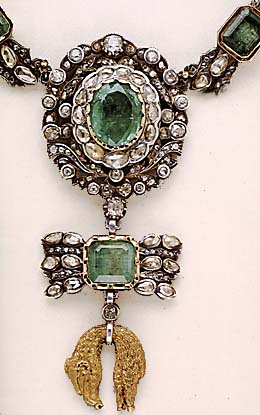 The unique collar of the Golden
Fleece shown at left was made c. 1700 for Ferdinand, Prince of Schwarzenberg,
in south Germany or Vienna in silver with diamonds, old Austrian emeralds and
a chased gold Fleece. It was in the famous Spada collection and is pictured in
full in the beautifully illustrated catalog of his personal collection Onori
e Glorie. As was true of all the great, ancient families the Schwarzenbergs
were proud of their status and capable of affording the most elegant and expensive
jewels.
The unique collar of the Golden
Fleece shown at left was made c. 1700 for Ferdinand, Prince of Schwarzenberg,
in south Germany or Vienna in silver with diamonds, old Austrian emeralds and
a chased gold Fleece. It was in the famous Spada collection and is pictured in
full in the beautifully illustrated catalog of his personal collection Onori
e Glorie. As was true of all the great, ancient families the Schwarzenbergs
were proud of their status and capable of affording the most elegant and expensive
jewels.
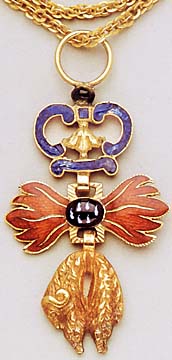 The princen bijou shown at
the right was one of a series in this peculiar style of toison made for the family
members of the Order between 1712 and 1860 that also belonged to Dr. Spada. Note
how vertically stretched the Fleece is, the shape of the head and the peculiar
horns which are more like those of a goat or a musk ox than a ram. This style
Fleece is only known to the Schwarzenbergs, only in this time period, and they
all were likely made by a local Bohemian or Austrian jeweler. There were seven
of them with various styles of elements in a leather case in the Spada collection
-- four princen and three full size. This example was made c. 1720-1732 for Adam
Francis, Prince of Schwarzenberg (No. A-630). Adam Francis was a supporter
of the Habsburg Emperor Charles VI in the war of the Spanish Succession and, following
the death of Ferdinand of Schwarzenberg in 1703, Adam Francis was made a knight
of the Fleece in the first batch of knights created by Charles in 1712.
The princen bijou shown at
the right was one of a series in this peculiar style of toison made for the family
members of the Order between 1712 and 1860 that also belonged to Dr. Spada. Note
how vertically stretched the Fleece is, the shape of the head and the peculiar
horns which are more like those of a goat or a musk ox than a ram. This style
Fleece is only known to the Schwarzenbergs, only in this time period, and they
all were likely made by a local Bohemian or Austrian jeweler. There were seven
of them with various styles of elements in a leather case in the Spada collection
-- four princen and three full size. This example was made c. 1720-1732 for Adam
Francis, Prince of Schwarzenberg (No. A-630). Adam Francis was a supporter
of the Habsburg Emperor Charles VI in the war of the Spanish Succession and, following
the death of Ferdinand of Schwarzenberg in 1703, Adam Francis was made a knight
of the Fleece in the first batch of knights created by Charles in 1712.
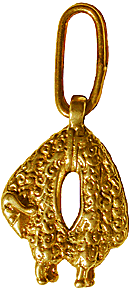 This soliltary Fleece may
be the only Schwarzenberg Fleece of the Bohemian type left as Dr. Spada's were
reportedly stolen and melted down some years ago. This one was made for Joseph
Adam (No. A-693) c. 1740-1780, more likely near the former year. It is
very similar in style and fleece treatment to Dr. Spada's shown above. The gold
wire suspension is very old itself and matches those found on some 1813-14 Canon
Crosses as replacement suspensions from the 1830-50 period. Joseph Adam was made
a Knight in 1732, the same year that Adam Francis died, and when he was only 10
years old. There must have been a pressing State reason to reward the Schwarzenbergs
so immediately, as although Imperial Archdukes were often made a Knight when still
children, it is rare for any others to be so chosen, and Joseph Adam remained
a Knight for 50 years.
This soliltary Fleece may
be the only Schwarzenberg Fleece of the Bohemian type left as Dr. Spada's were
reportedly stolen and melted down some years ago. This one was made for Joseph
Adam (No. A-693) c. 1740-1780, more likely near the former year. It is
very similar in style and fleece treatment to Dr. Spada's shown above. The gold
wire suspension is very old itself and matches those found on some 1813-14 Canon
Crosses as replacement suspensions from the 1830-50 period. Joseph Adam was made
a Knight in 1732, the same year that Adam Francis died, and when he was only 10
years old. There must have been a pressing State reason to reward the Schwarzenbergs
so immediately, as although Imperial Archdukes were often made a Knight when still
children, it is rare for any others to be so chosen, and Joseph Adam remained
a Knight for 50 years.
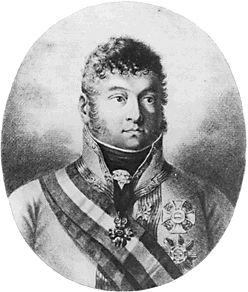
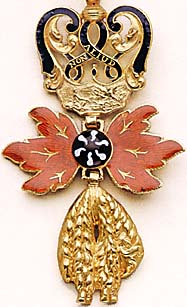 On
the death of Joseph Adam in 1782, Joseph-Jean of Schwarzenberg (No. A-816)
was made a Knight in the same year, but he only lived until 1789, dying at the
age of 47. It is interesting that even the nobility, with all their wealth and
access to contemporary medicine, usually died at the ages of 40-50 at this time.
It was then some 20 years before the Schwarzenbergs resumed their presence as
Knights of the Golden Fleece. In 1808 Joseph-Jean (No. A-877), son of the
former Knight of the same name, was admitted to the Order, and, in 1809, his famous
brother Charles Philipp (No. A-887),
the Field Marshal who led the allies to victory at Leipzig, was admitted to the
Order. A cautious and careful man ill disposed to take risks, he continued his
efforts after the Congress of Vienna, along with Stadion, to re-establish a German
Empire under Habsburg domination that would restrain Prussia, whose growth was
Schwarzenberg's great fear. The equally conservative Metternich cared little for
reviving a Medieval Empire but mainly was worried about the expansion of Russia,
and so Schwarzenberg's manuevering achieved little before his early death. The
Fleece at the right, also from the Spada cased set, belonged to one of these two
brothers and dates from c. 1810. Note how some careless person has installed the
Fleece backward on the Pierre a Fois and has it facing the right. Some 60-70 years
after the first Schwarzenberg Fleece shown above, this one is little different
in its unique, Schwarzenberg styling. Charles died in 1820 and Joseph-Jean in
1833. On the left is a contemporary engraving of Field Marshal Charles of Schwarzenberg
c. 1812-1820 wearing, among other orders, a standard bijou of the Golden Fleece.
On
the death of Joseph Adam in 1782, Joseph-Jean of Schwarzenberg (No. A-816)
was made a Knight in the same year, but he only lived until 1789, dying at the
age of 47. It is interesting that even the nobility, with all their wealth and
access to contemporary medicine, usually died at the ages of 40-50 at this time.
It was then some 20 years before the Schwarzenbergs resumed their presence as
Knights of the Golden Fleece. In 1808 Joseph-Jean (No. A-877), son of the
former Knight of the same name, was admitted to the Order, and, in 1809, his famous
brother Charles Philipp (No. A-887),
the Field Marshal who led the allies to victory at Leipzig, was admitted to the
Order. A cautious and careful man ill disposed to take risks, he continued his
efforts after the Congress of Vienna, along with Stadion, to re-establish a German
Empire under Habsburg domination that would restrain Prussia, whose growth was
Schwarzenberg's great fear. The equally conservative Metternich cared little for
reviving a Medieval Empire but mainly was worried about the expansion of Russia,
and so Schwarzenberg's manuevering achieved little before his early death. The
Fleece at the right, also from the Spada cased set, belonged to one of these two
brothers and dates from c. 1810. Note how some careless person has installed the
Fleece backward on the Pierre a Fois and has it facing the right. Some 60-70 years
after the first Schwarzenberg Fleece shown above, this one is little different
in its unique, Schwarzenberg styling. Charles died in 1820 and Joseph-Jean in
1833. On the left is a contemporary engraving of Field Marshal Charles of Schwarzenberg
c. 1812-1820 wearing, among other orders, a standard bijou of the Golden Fleece.
From this time the Schwarzenbergs have been represented in the ranks of Knights
of the Golden Fleece up to the present day. Prince Felix of Schwarzenberg commanded
the forces that supressed the Hungarian revolt of 1848-49, and was the first Prime
Minister of the young Emperor Franz Joseph from 1848 to his death in 1852, so
we see the family continuing to fill the most important positions in the Imperial
administration. Adolphe (No. A-933) was a Knight in 1836 and died in 1854;
Charles (No. A-965) a Knight in 1852 and died in 1858; Edmond (No. A-990)
a Knight in 1862 and died in 1873. After a lapse of eight years Charles (No.
A-1063) became a Knight in 1881 and died in 1904; Adolphe Joseph (No. A-1092)
a Knight in 1889 and died in 1914; and the last pre-WW I member was another Charles
(No. A-1161) who became a Knight in 1907 and died in 1913. Crown Prince
Rudolf, in his moments of liberal philosophizing, found the conservative nobility
of Bohemia, and especially the Schwarzenbergs, unsymphathetic, calling them "feudal
and nationless gentlemen". We thus see that the inate conservatism that made
the Schwarzenbergs attractive and loyal officials also made them increasingly
out of date anachronisms. Nevertheless, they remained a cornerstone of the fashionable
nobility and powerful members of the court until the final, whispering end in
November, 1918, and were mentioned in the same breath as the Archdukes, the Metternichs
and the Hoyos.
During WW I Jean (No. A-1193) was made a Knight in 1915 and lived until
1938. When Archduke Otto resumed naming members of the Fleece he apointed Joseph
of Schwartzenberg (No. A-1252) a Knight in 1951, and later Charles (No.
A-1278) in 1960. Over 374 years there have been 17 Schwarzenberg members of
the Order of the Golden Fleece, spaning from the 30 Year's War until today. As
is true for few other familes, the Schwarzenbergs show the continuing links between
our ancient past and today, and the current relevance of such institutions as
the ancient Orders of Knighthood.
Schwarzenberg Military Units Page
Return to the Golden Fleece Insignia Page
Return to Society of the Golden Fleece
Stephen Herold - Medals, Orders & Decorations
 The unique collar of the Golden
Fleece shown at left was made c. 1700 for Ferdinand, Prince of Schwarzenberg,
in south Germany or Vienna in silver with diamonds, old Austrian emeralds and
a chased gold Fleece. It was in the famous Spada collection and is pictured in
full in the beautifully illustrated catalog of his personal collection Onori
e Glorie. As was true of all the great, ancient families the Schwarzenbergs
were proud of their status and capable of affording the most elegant and expensive
jewels.
The unique collar of the Golden
Fleece shown at left was made c. 1700 for Ferdinand, Prince of Schwarzenberg,
in south Germany or Vienna in silver with diamonds, old Austrian emeralds and
a chased gold Fleece. It was in the famous Spada collection and is pictured in
full in the beautifully illustrated catalog of his personal collection Onori
e Glorie. As was true of all the great, ancient families the Schwarzenbergs
were proud of their status and capable of affording the most elegant and expensive
jewels. The princen bijou shown at
the right was one of a series in this peculiar style of toison made for the family
members of the Order between 1712 and 1860 that also belonged to Dr. Spada. Note
how vertically stretched the Fleece is, the shape of the head and the peculiar
horns which are more like those of a goat or a musk ox than a ram. This style
Fleece is only known to the Schwarzenbergs, only in this time period, and they
all were likely made by a local Bohemian or Austrian jeweler. There were seven
of them with various styles of elements in a leather case in the Spada collection
-- four princen and three full size. This example was made c. 1720-1732 for Adam
Francis, Prince of Schwarzenberg (No. A-630). Adam Francis was a supporter
of the Habsburg Emperor Charles VI in the war of the Spanish Succession and, following
the death of Ferdinand of Schwarzenberg in 1703, Adam Francis was made a knight
of the Fleece in the first batch of knights created by Charles in 1712.
The princen bijou shown at
the right was one of a series in this peculiar style of toison made for the family
members of the Order between 1712 and 1860 that also belonged to Dr. Spada. Note
how vertically stretched the Fleece is, the shape of the head and the peculiar
horns which are more like those of a goat or a musk ox than a ram. This style
Fleece is only known to the Schwarzenbergs, only in this time period, and they
all were likely made by a local Bohemian or Austrian jeweler. There were seven
of them with various styles of elements in a leather case in the Spada collection
-- four princen and three full size. This example was made c. 1720-1732 for Adam
Francis, Prince of Schwarzenberg (No. A-630). Adam Francis was a supporter
of the Habsburg Emperor Charles VI in the war of the Spanish Succession and, following
the death of Ferdinand of Schwarzenberg in 1703, Adam Francis was made a knight
of the Fleece in the first batch of knights created by Charles in 1712. This soliltary Fleece may
be the only Schwarzenberg Fleece of the Bohemian type left as Dr. Spada's were
reportedly stolen and melted down some years ago. This one was made for Joseph
Adam (No. A-693) c. 1740-1780, more likely near the former year. It is
very similar in style and fleece treatment to Dr. Spada's shown above. The gold
wire suspension is very old itself and matches those found on some 1813-14 Canon
Crosses as replacement suspensions from the 1830-50 period. Joseph Adam was made
a Knight in 1732, the same year that Adam Francis died, and when he was only 10
years old. There must have been a pressing State reason to reward the Schwarzenbergs
so immediately, as although Imperial Archdukes were often made a Knight when still
children, it is rare for any others to be so chosen, and Joseph Adam remained
a Knight for 50 years.
This soliltary Fleece may
be the only Schwarzenberg Fleece of the Bohemian type left as Dr. Spada's were
reportedly stolen and melted down some years ago. This one was made for Joseph
Adam (No. A-693) c. 1740-1780, more likely near the former year. It is
very similar in style and fleece treatment to Dr. Spada's shown above. The gold
wire suspension is very old itself and matches those found on some 1813-14 Canon
Crosses as replacement suspensions from the 1830-50 period. Joseph Adam was made
a Knight in 1732, the same year that Adam Francis died, and when he was only 10
years old. There must have been a pressing State reason to reward the Schwarzenbergs
so immediately, as although Imperial Archdukes were often made a Knight when still
children, it is rare for any others to be so chosen, and Joseph Adam remained
a Knight for 50 years.
 On
the death of Joseph Adam in 1782, Joseph-Jean of Schwarzenberg (No. A-816)
was made a Knight in the same year, but he only lived until 1789, dying at the
age of 47. It is interesting that even the nobility, with all their wealth and
access to contemporary medicine, usually died at the ages of 40-50 at this time.
It was then some 20 years before the Schwarzenbergs resumed their presence as
Knights of the Golden Fleece. In 1808 Joseph-Jean (No. A-877), son of the
former Knight of the same name, was admitted to the Order, and, in 1809, his famous
brother Charles Philipp (No. A-887),
the Field Marshal who led the allies to victory at Leipzig, was admitted to the
Order. A cautious and careful man ill disposed to take risks, he continued his
efforts after the Congress of Vienna, along with Stadion, to re-establish a German
Empire under Habsburg domination that would restrain Prussia, whose growth was
Schwarzenberg's great fear. The equally conservative Metternich cared little for
reviving a Medieval Empire but mainly was worried about the expansion of Russia,
and so Schwarzenberg's manuevering achieved little before his early death. The
Fleece at the right, also from the Spada cased set, belonged to one of these two
brothers and dates from c. 1810. Note how some careless person has installed the
Fleece backward on the Pierre a Fois and has it facing the right. Some 60-70 years
after the first Schwarzenberg Fleece shown above, this one is little different
in its unique, Schwarzenberg styling. Charles died in 1820 and Joseph-Jean in
1833. On the left is a contemporary engraving of Field Marshal Charles of Schwarzenberg
c. 1812-1820 wearing, among other orders, a standard bijou of the Golden Fleece.
On
the death of Joseph Adam in 1782, Joseph-Jean of Schwarzenberg (No. A-816)
was made a Knight in the same year, but he only lived until 1789, dying at the
age of 47. It is interesting that even the nobility, with all their wealth and
access to contemporary medicine, usually died at the ages of 40-50 at this time.
It was then some 20 years before the Schwarzenbergs resumed their presence as
Knights of the Golden Fleece. In 1808 Joseph-Jean (No. A-877), son of the
former Knight of the same name, was admitted to the Order, and, in 1809, his famous
brother Charles Philipp (No. A-887),
the Field Marshal who led the allies to victory at Leipzig, was admitted to the
Order. A cautious and careful man ill disposed to take risks, he continued his
efforts after the Congress of Vienna, along with Stadion, to re-establish a German
Empire under Habsburg domination that would restrain Prussia, whose growth was
Schwarzenberg's great fear. The equally conservative Metternich cared little for
reviving a Medieval Empire but mainly was worried about the expansion of Russia,
and so Schwarzenberg's manuevering achieved little before his early death. The
Fleece at the right, also from the Spada cased set, belonged to one of these two
brothers and dates from c. 1810. Note how some careless person has installed the
Fleece backward on the Pierre a Fois and has it facing the right. Some 60-70 years
after the first Schwarzenberg Fleece shown above, this one is little different
in its unique, Schwarzenberg styling. Charles died in 1820 and Joseph-Jean in
1833. On the left is a contemporary engraving of Field Marshal Charles of Schwarzenberg
c. 1812-1820 wearing, among other orders, a standard bijou of the Golden Fleece.